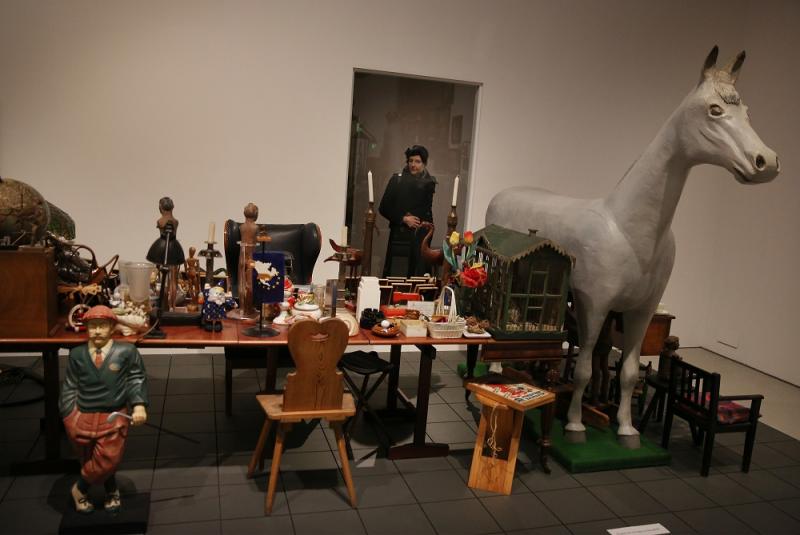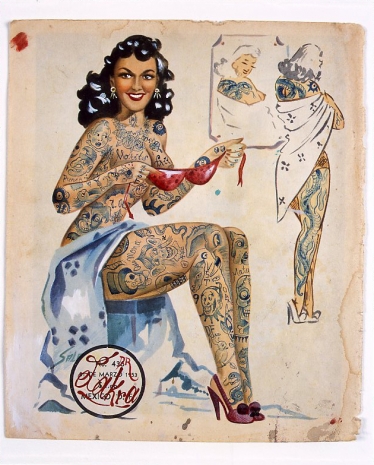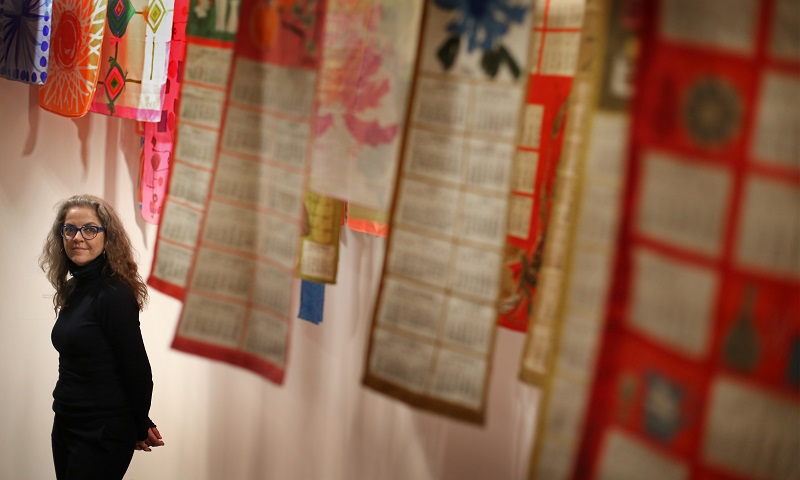Magnificent Obsessions, Barbican Art Gallery | reviews, news & interviews
Magnificent Obsessions, Barbican Art Gallery
Magnificent Obsessions, Barbican Art Gallery
Jumble sale or treasure trove? Exploring the collections of 14 postwar and contemporary artists

The title has it about right: no matter what it is they are busily acquiring, collectors seem to be an obsessive bunch, and their obsessions can achieve quite magnificent proportions. The stereotyped image of the collector as a socially challenged monomaniac doesn’t really fit with the popular understanding of the artistic temperament, though.
 Intuitively we imagine that artists collect things that relate to their own work. While this is certainly not always the case, for the 14 featured artists, collecting provides an alternative means of exploring a preoccupation or theme and for Mexican artist Dr Lakra, who treats vintage pin-ups as blank canvases to be covered with tattoos (pictured right: The Mirror, 2003), collected objects are raw materials, to be assimilated and absorbed into a new object.
Intuitively we imagine that artists collect things that relate to their own work. While this is certainly not always the case, for the 14 featured artists, collecting provides an alternative means of exploring a preoccupation or theme and for Mexican artist Dr Lakra, who treats vintage pin-ups as blank canvases to be covered with tattoos (pictured right: The Mirror, 2003), collected objects are raw materials, to be assimilated and absorbed into a new object.
Interestingly, most of the collections here emphasise everyday objects, popular art, ephemera, bric-a-brac, natural objects and curiosities, things, in other words, that can be piled up and mixed together in a way that would be difficult if not downright irresponsible with an art collection. Occupying a separate bay of the gallery, and retaining the artist’s own methods and styles of display, the visual impact of each collection is maximised and feels in some way characteristic of each artist.
Andy Warhol was a pathological collector, who enjoyed, above all, the moment of acquisition. While some items, notably Heinz Ketchup and Campbell’s tomato juice boxes, reappeared in his art, many never saw the light of day, so that when his collection was auctioned after his death, many lots were still in the boxes and bags Warhol had received them in. The exhibition makes much of Warhol’s collecting habits as symptomatic of his various hang-ups and neuroses, his need to accumulate possessions a reaction against a spartan childhood, his interest in domestic objects, like his famous cookie jars, evidence of his longing for an imagined, idealised past.
 In contrast, photographer Martin Parr rejects any suggestion that his much-celebrated collections of postcards (pictured left: Flying postcard, 1960-90) and objects say anything about him, other than that he is a collector. In fact, to Parr, photography is a form of collecting, and he has written that: “By applying some order to our chaotic world, and assembling things into categories and ultimately into a book or a show, I can make a more coherent statement about my relationship to the world.”
In contrast, photographer Martin Parr rejects any suggestion that his much-celebrated collections of postcards (pictured left: Flying postcard, 1960-90) and objects say anything about him, other than that he is a collector. In fact, to Parr, photography is a form of collecting, and he has written that: “By applying some order to our chaotic world, and assembling things into categories and ultimately into a book or a show, I can make a more coherent statement about my relationship to the world.”
Parr’s collections of ephemera and political memorabilia, as well as what has become a vast and historically important collection of postcards, are meticulously organised, and serve as an extension to his activities as a photographer. Tourism, class and consumerism are all major themes that are echoed in his postcards and collections of souvenirs and trinkets.
An interesting aspect of Parr's postcard collections and also perhaps key to understanding artists’ collections more generally, is the repetition and reuse of images, themes and motifs. By virtue of their sameness, postcards celebrating the fundamentally anonymous and banal, like shopping centres and hotel rooms, invite categorisation for its own sake. Likewise, seaside postcards often replicate designs and images, with only the name of the resort to differentiate between them.
 The visual effect that can be achieved by repetition, and by amassing many similar and identical objects is beautifully demonstrated by Pae White’s collection of textiles (pictured right), displayed on so many washing lines that fill the space and echo her own work hanging nearby.
The visual effect that can be achieved by repetition, and by amassing many similar and identical objects is beautifully demonstrated by Pae White’s collection of textiles (pictured right), displayed on so many washing lines that fill the space and echo her own work hanging nearby.
Sol LeWitt explores repeating motifs in his photobook, Autobiography, 1980, in which he catalogues every detail of his Manhattan loft, from plumbing and bins to saucepans and bookcases. It is a curious document, because while it contains any number of minor intrusions into his own privacy, it is unenlightening as an autobiography, challenging the idea that possessions are a tool with which to access their owner’s psychology. It seems noteworthy, then, that LeWitt’s own collection, while reflecting his own interests, is essentially outward-looking and represents at heart a process of engagement and exchange with other artists.
For the ceramic artist Edmund de Waal, collecting is firmly tied to his own personal narrative. His collections of fossils, stones, and other objects are displayed here much as he remembers arranging them as a child, while his collection of Japanese netsuke is closely linked to his family history. They serve as an interesting contrast to one of de Waal’s own works, From the Collection of a Private Man, 2011, in which neutral-coloured pots and vessels are grouped on shelves. The grouping together of forms implies a collection but the blank, characterless objects communicate nothing, and in so doing they emphasise the self-revelatory nature of de Waal’s own childhood collections.
Explore topics
Share this article
The future of Arts Journalism
You can stop theartsdesk.com closing!
We urgently need financing to survive. Our fundraising drive has thus far raised £49,000 but we need to reach £100,000 or we will be forced to close. Please contribute here: https://gofund.me/c3f6033d
And if you can forward this information to anyone who might assist, we’d be grateful.

Subscribe to theartsdesk.com
Thank you for continuing to read our work on theartsdesk.com. For unlimited access to every article in its entirety, including our archive of more than 15,000 pieces, we're asking for £5 per month or £40 per year. We feel it's a very good deal, and hope you do too.
To take a subscription now simply click here.
And if you're looking for that extra gift for a friend or family member, why not treat them to a theartsdesk.com gift subscription?
more Visual arts
 'We are bowled over!' Thank you for your messages of love and support
Much-appreciated words of commendation from readers and the cultural community
'We are bowled over!' Thank you for your messages of love and support
Much-appreciated words of commendation from readers and the cultural community
 Photo Oxford 2025 review - photography all over the town
At last, a UK festival that takes photography seriously
Photo Oxford 2025 review - photography all over the town
At last, a UK festival that takes photography seriously
![SEX MONEY RACE RELIGION [2016] by Gilbert and George. Installation shot of Gilbert & George 21ST CENTURY PICTURES Hayward Gallery](https://theartsdesk.com/sites/default/files/styles/thumbnail/public/mastimages/Gilbert%20%26%20George_%2021ST%20CENTURY%20PICTURES.%20SEX%20MONEY%20RACE%20RELIGION%20%5B2016%5D.%20Photo_%20Mark%20Blower.%20Courtesy%20of%20the%20Gilbert%20%26%20George%20and%20the%20Hayward%20Gallery._0.jpg?itok=7tVsLyR-) Gilbert & George, 21st Century Pictures, Hayward Gallery review - brash, bright and not so beautiful
The couple's coloured photomontages shout louder than ever, causing sensory overload
Gilbert & George, 21st Century Pictures, Hayward Gallery review - brash, bright and not so beautiful
The couple's coloured photomontages shout louder than ever, causing sensory overload
 Lee Miller, Tate Britain review - an extraordinary career that remains an enigma
Fashion photographer, artist or war reporter; will the real Lee Miller please step forward?
Lee Miller, Tate Britain review - an extraordinary career that remains an enigma
Fashion photographer, artist or war reporter; will the real Lee Miller please step forward?
 Kerry James Marshall: The Histories, Royal Academy review - a triumphant celebration of blackness
Room after room of glorious paintings
Kerry James Marshall: The Histories, Royal Academy review - a triumphant celebration of blackness
Room after room of glorious paintings
 Folkestone Triennial 2025 - landscape, seascape, art lovers' escape
Locally rooted festival brings home many but not all global concerns
Folkestone Triennial 2025 - landscape, seascape, art lovers' escape
Locally rooted festival brings home many but not all global concerns
 Sir Brian Clarke (1953-2025) - a personal tribute
Remembering an artist with a gift for the transcendent
Sir Brian Clarke (1953-2025) - a personal tribute
Remembering an artist with a gift for the transcendent
 Emily Kam Kngwarray, Tate Modern review - glimpses of another world
Pictures that are an affirmation of belonging
Emily Kam Kngwarray, Tate Modern review - glimpses of another world
Pictures that are an affirmation of belonging
 Kiefer / Van Gogh, Royal Academy review - a pairing of opposites
Small scale intensity meets large scale melodrama
Kiefer / Van Gogh, Royal Academy review - a pairing of opposites
Small scale intensity meets large scale melodrama
 Jenny Saville: The Anatomy of Painting, National Portrait Gallery review - a protégé losing her way
A brilliant painter in search of a worthwhile subject
Jenny Saville: The Anatomy of Painting, National Portrait Gallery review - a protégé losing her way
A brilliant painter in search of a worthwhile subject
 Abstract Erotic, Courtauld Gallery review - sculpture that is sensuous, funny and subversive
Testing the boundaries of good taste, and winning
Abstract Erotic, Courtauld Gallery review - sculpture that is sensuous, funny and subversive
Testing the boundaries of good taste, and winning
 Edward Burra, Tate Britain review - watercolour made mainstream
Social satire with a nasty bite
Edward Burra, Tate Britain review - watercolour made mainstream
Social satire with a nasty bite

Add comment